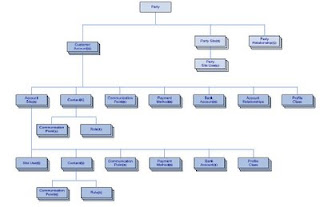Trading Community Model:
Trading Community is defined as a group of entities taking part
in commerce.Trading Community includes both persons and Organization.
What is Oracle TCA?
TCA: Trading Community Architecture.
Oracle’s Central Customer Data Repository underlying all
Oracle Applications. TCA is a Model, an Architecture and
NOT a Module.
Evolution of TCA Release:

Oracle Trading Community Architecture (TCA) is a data model
that allows you to manage complex information about the
parties, or customers, who belong to your commercial community,
including organizations, locations, and the network of hierarchical
relationships among them.

The below diagram depicts the relationship among the entities
of Trading Community.
Entity Relationship:

TCA Key Entities:
1. Parties:
“Party” is an entity in the Trading Community Model that can
enter into business relationships.
A party is a person, organization (branch, subsidiary, legalentity,
holding company, etc) or relationship (this is a relationship
between two parties).
2. Party Relationships:
A relationship is a state of connectedness between two parties ,
Each relationship consists of two entities; a subject and an object.
Relationship - Associates any two parties
Binary relationship between two parties Inter-Company and
Intra-company relationships Non-business relationships too Are
reciprocalUnlimited in number Dynamic in natureBoth seeded or
user-defined Relationship Types Relationship itself is stored as a
partyAny number of relationships between two organizations
(org-to-org) or two persons (person-to-person) or anorganization
and a person (org-to-person).
The relationship model enables you to :
- Understand the complex relationships among members of your
trading community.
- Use this information to make better business decisions.
3. Customer Accounts:
“Customer Accounts ” is used to represent a party with whom
the deploying company has a selling relationship, regardless of
whether anything has actually been purchased or serviced.
An Account cannot be created without party.
4. Locations:
A geographic location, physical place, usually with an address.
Any number of location types. (e.g., bill-to, ship-to, mail-to).
Allows for restricted use of a location (begin / end date).
Is a Party Site with one or more site uses Only one of the
Party Sites can become an “Identifying Address” for the Party
An Account Site in the context of an Account .
Geographic location including Spatial content Many to Many
relationship between party and location.
Party Site: Links a Party with a Location and describes the usage
of that Location (e.g., mailing address, billing address, home address, etc.).
Parties may be associated to one or more Locations and any one
location may have one or more uses.
5. Contracts.
A Person related to an Organization, this can be a relationship
between an organization and a person as well as between two people.

Party Vs Account:
====================
The Concept of Customer is sepearted in two layers ,
- Party Layer.
- Account Layer.
CRM applications are referring to the Party layer when they
refer to “Customer”.
ERP Applications, on the other hand, are referring to the
Account layer, when they refer to “Customer”.
The word “Customer” is the combination of both the “Party layer”
and the “Account layer”.
- Party layer exists independent of any selling or buying relationship.
- Customer Account layer exists in the context of a Party and only
when a selling relationship exists.
The Party Layer captures intrinsic truths about a person or
organization. The Account Layer captures the details describing
the Party’s financial relationship with the implementing
organization. The Account Layer cannot exist without the Party Layer.
Party:
The unique set of truths about a person, organization, group or
relationship. An entity that can enter into a business relationship.
Person - A unique individual (dead or alive) of interest to the owner
of the software.
Organization - A legal entity recognized by some government authority.
Group - a combination of two or more people, organizations or
groups of created for the use of the owner of the software.
Relationship - links two Parties, regardless of type.
Once a Party Relationship is formed, it may become a Party
in its own right. A Party can belong to any number of relationships.
The combination of a party and its account(s) is considered a customer
Customer Module Overview:
• TCA is designed to encapsulate all members of a ‘trading community.’
• A trading community may include customers, prospects, suppliers,
distributors, resellers, consortiums, etc.
• TCA not only allows for the tracking of relationships between the
implementing organization and its trading partners, but also tracks
relationships between the trading partners themselves.

Customer Standard Strucutre in 11i.:

Account Layer - Components:
===========================
Account:
The attributes of the implementing organization’s financial
relationship with a party, Cannot exist without a Party.
Account Site:
A Party Site that is used within the context of an Account.
Account Site Use:
Use of an Account Site (e.g.billing, shipping).
Account Relationships:
Established between accounts to allow sharing of billing, shipping,
and pricing information.
- One way or bi-directional,
- 1:1 Relationships – not used for multiple levels of a hierarchy .
Party Layer components:
================================
Party: An entity that can enter into a business relationship
- Person (Mr SMITH).
- Organization (ABC) .
Party Relationship: A relationship between two parties .
- Mr. Smith “Contact Of” ABC
- ABC Handhelds “Division Of” ABC - HQ
Location: Essentially an address.
Party Site: The connection between a location and a party that
indicates that a particular location is valid for that party.
Party Site Use: Use of a Party Site (e.g. billing, shipping, purchasing).
Entering orImporting Customer Data into TCA:

No comments:
Post a Comment